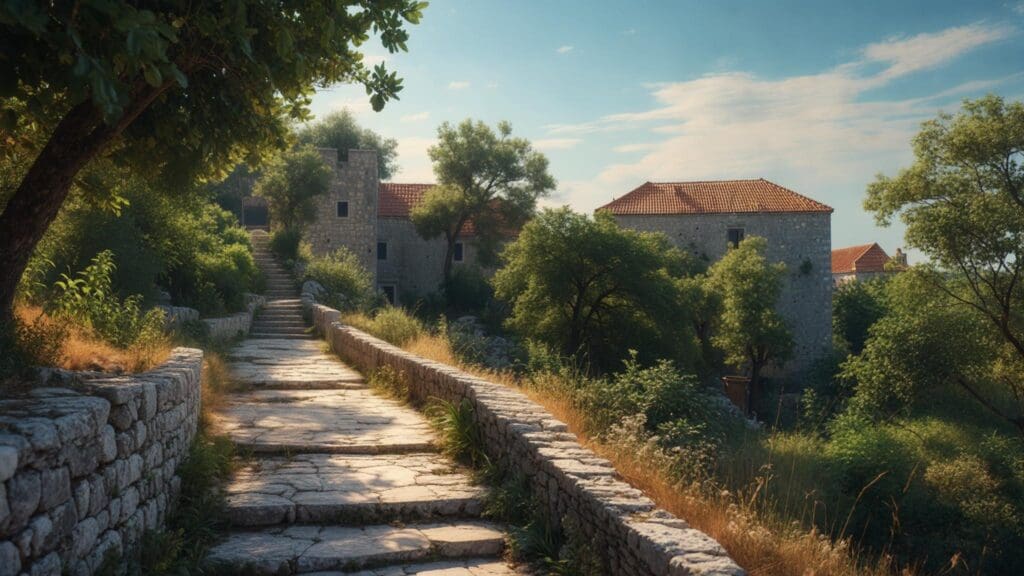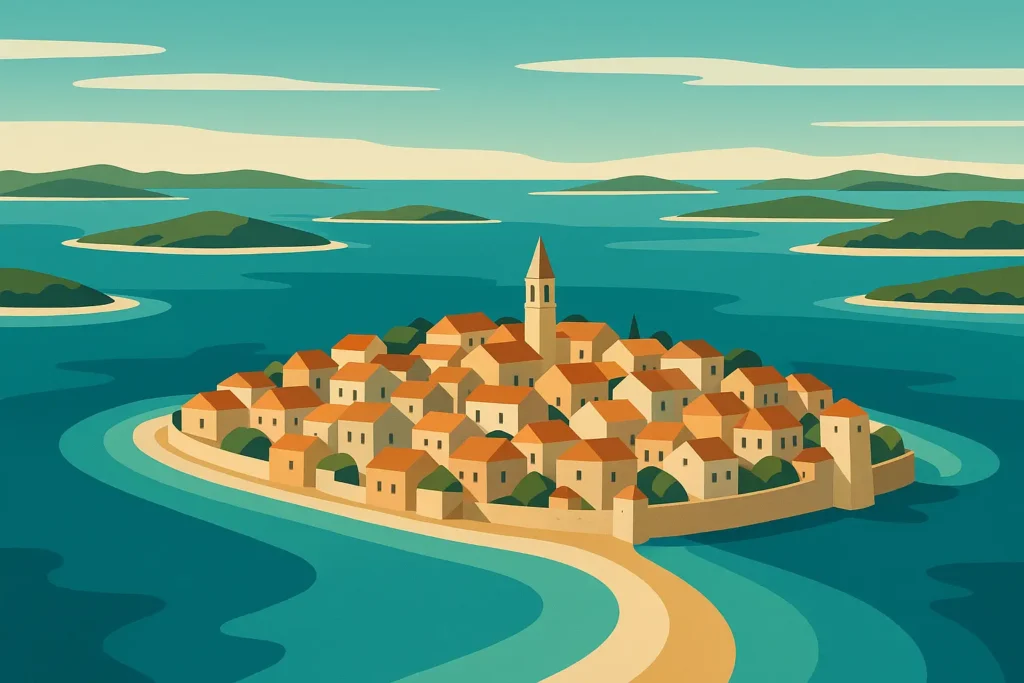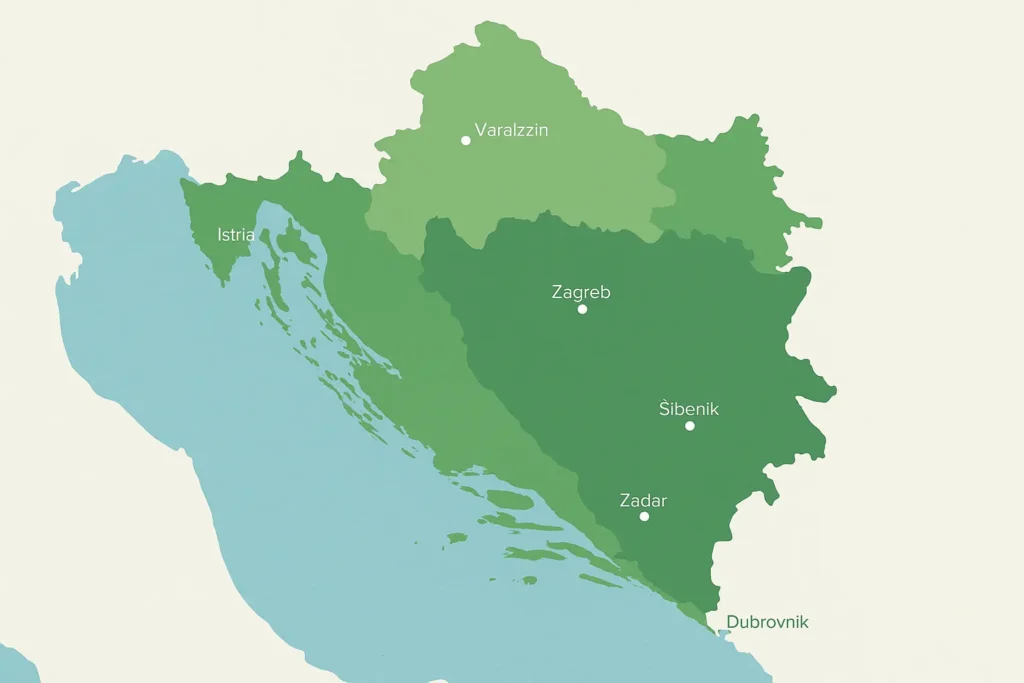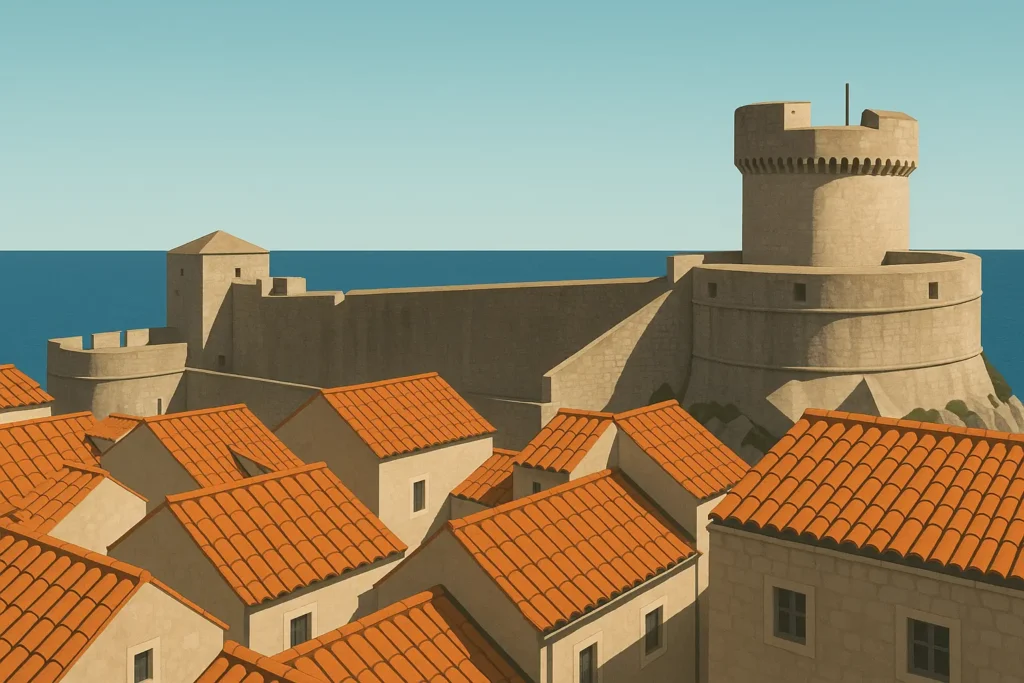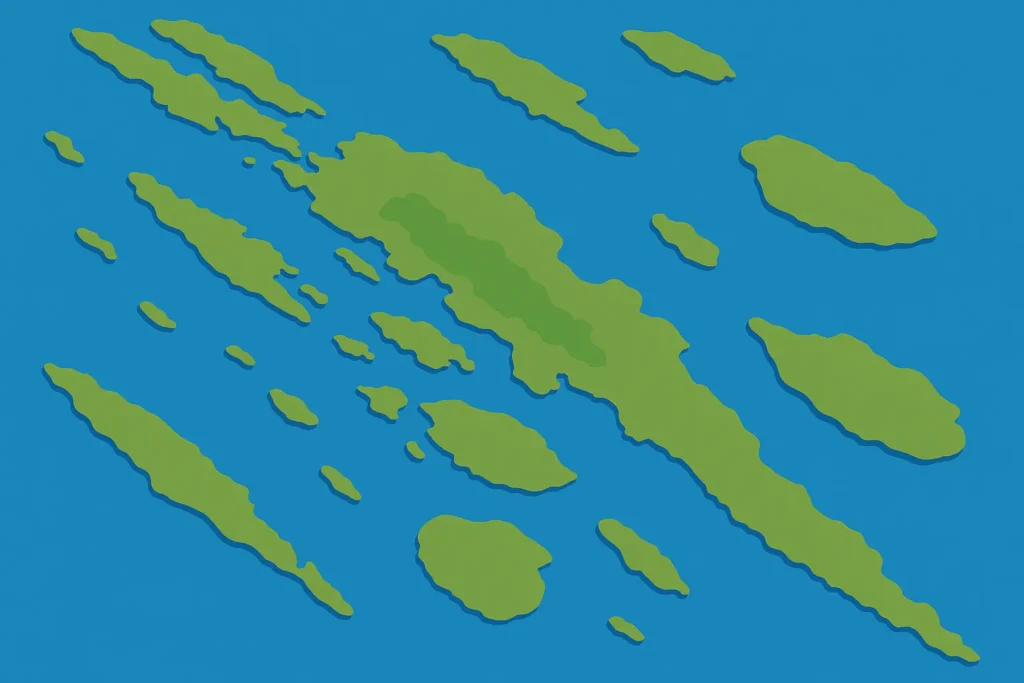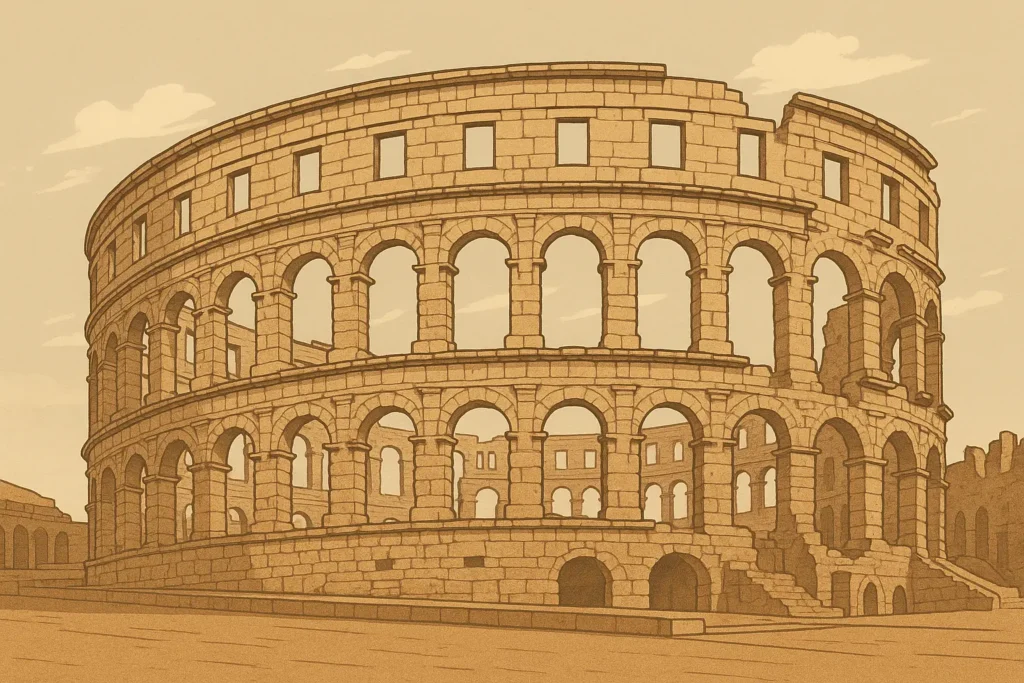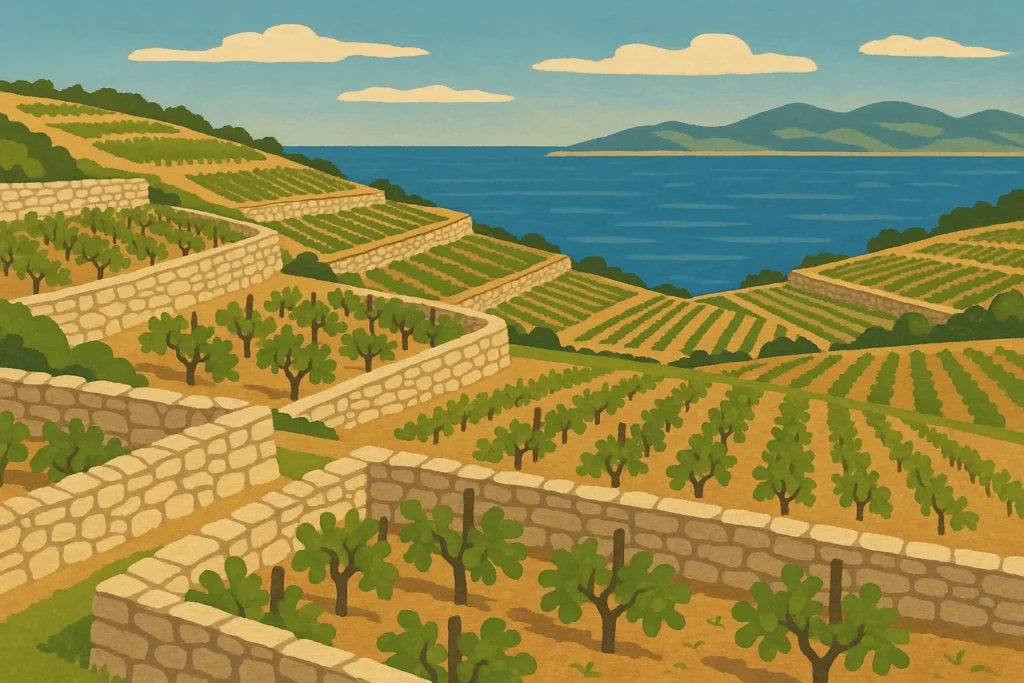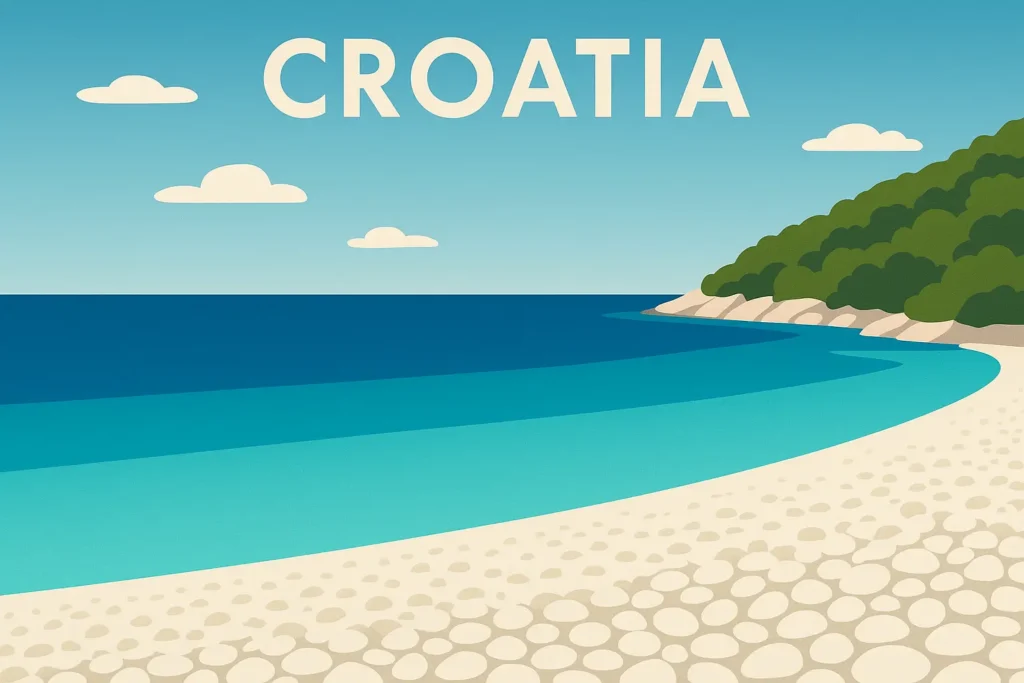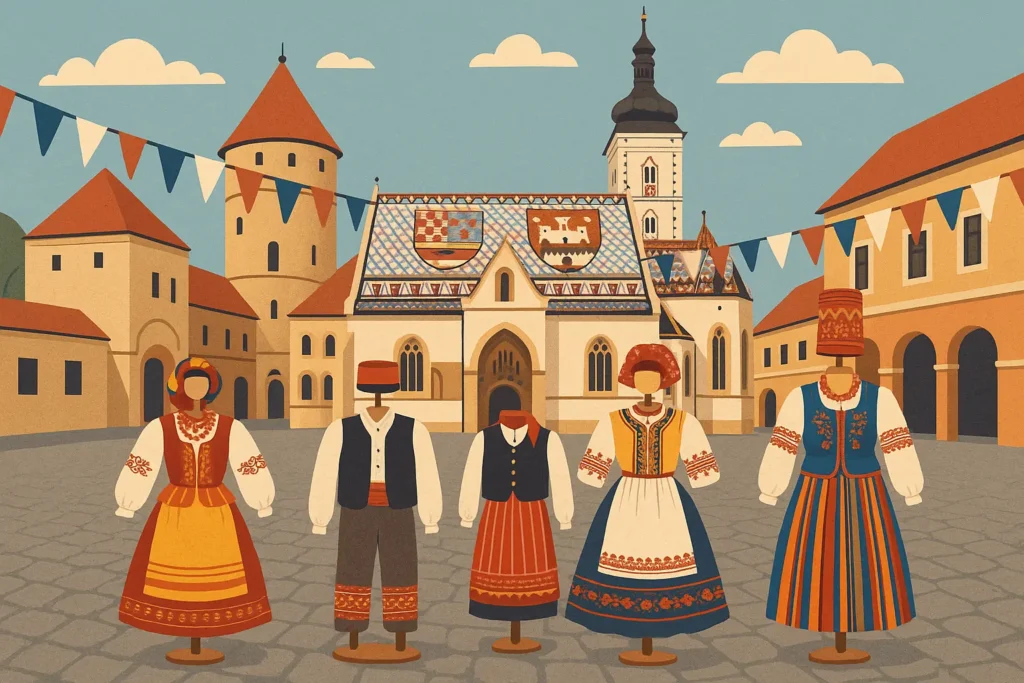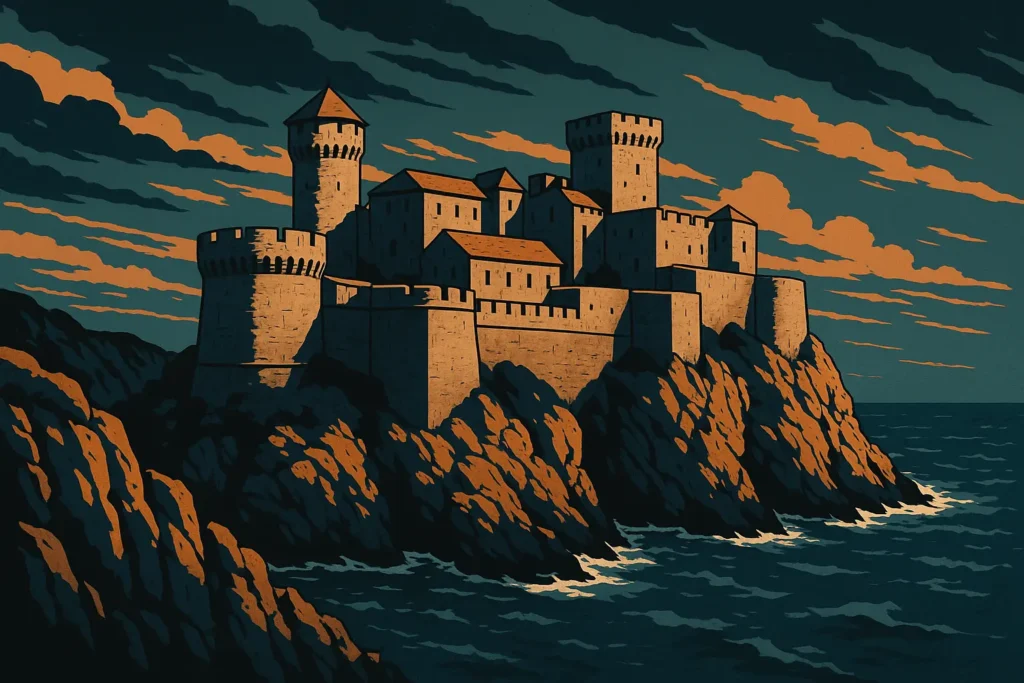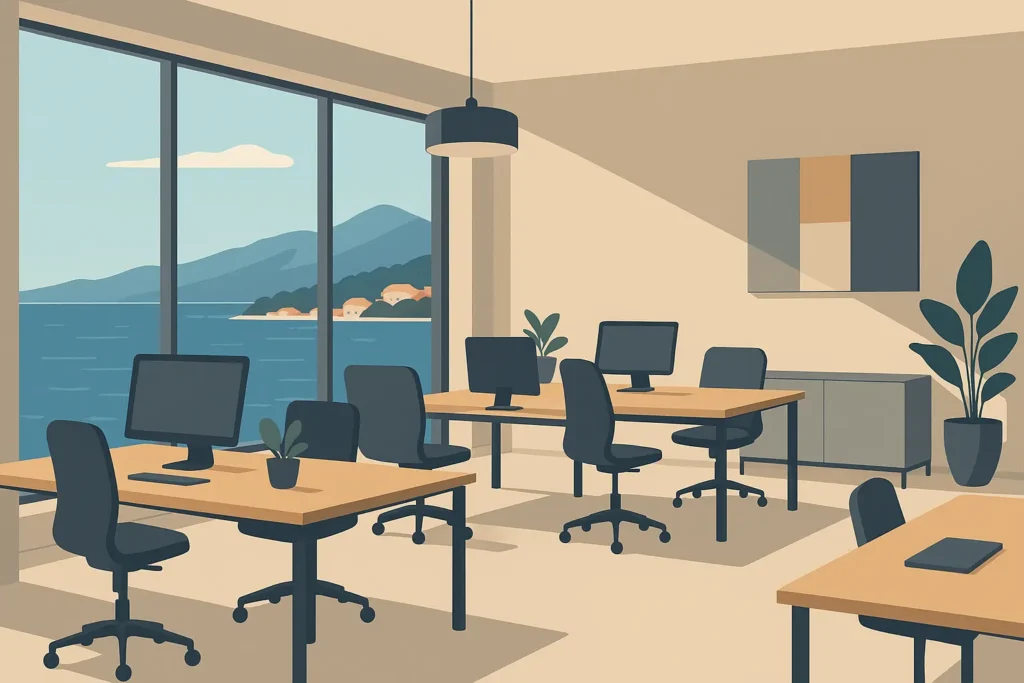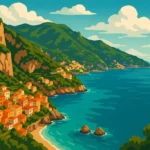Croatia has become one of Europe’s fastest-growing destinations, with tourism increasing by 15% annually over the past five years according to the Croatian National Tourist Board. Last summer, I watched my friend Sarah frantically scroll through dozens of conflicting Croatia guides at 2 AM, three weeks before her honeymoon departure. She’d fallen into the classic trap – too many options, not enough clarity on what actually works.
Take the stress out of travel with our easy-to-use Vacation Planner
Look, I get it. Planning a Croatia trip can feel overwhelming when every blog promises “the perfect itinerary” but leaves you more confused than when you started. This guide cuts through the noise with 25 carefully tested itineraries that match your specific travel style, timeline, and budget. I’ve spent years exploring every corner of this stunning country, from the bustling streets of Dubrovnik to the hidden coves of Vis Island, and I’m sharing the exact croatia itinerary frameworks that consistently deliver unforgettable experiences – along with the honest reality checks other guides won’t tell you.
Streamline your honeymoon itinerary with our free Honeymoon Planner
Quick Resources:
-
Plan your trip stress-free with the Vacation Planner
-
Use our free Honeymoon Planner to map your romantic escape
-
Budget smart with our free Bachelorette Budget Calculator
-
Check out our full suite of tools at All Wedding Tools
TL;DR
- Croatia requires minimum 7 days for highlights, 10-14 days for comprehensive experience
- Shoulder seasons (May-June, September-October) offer best value with excellent weather
- Island hopping works best April through October with reliable ferry schedules
- Budget varies dramatically: backpacker €30-50/day vs luxury €200-400/day
- Driving provides maximum flexibility but public transport works for city-focused trips
- Peak season (July-August) brings 3-4x higher costs but guaranteed weather
- Cultural sites remain accessible year-round while islands have seasonal limitations
- Solo travelers need flexible itineraries, families require child-friendly pacing
- Themed trips (wine, adventure, romance) work best with 10+ day timeframes
- Game of Thrones locations concentrate in Dubrovnik and Split regions
Essential Planning Factors for Your Croatia Adventure
Before diving into specific itineraries, let’s talk about what actually matters when planning your trip. Croatia’s not just another Mediterranean destination – it’s got unique quirks that can make or break your experience if you don’t plan accordingly.
Croatia’s elongated coastline stretches over 1,100 miles, creating completely different regional experiences. Dalmatia gives you dramatic coastlines and historic cities, Istria feels like Italy’s cooler cousin with truffle hunting and hilltop towns, while inland areas offer natural wonders without the coastal price tags.
Here’s the thing nobody tells you: timing isn’t just about weather – it’s about whether your croatia itinerary will actually work. Ferry schedules change dramatically by season, restaurants close for months, and what looks like a simple day trip in summer becomes impossible in winter.
| Planning Factor | Peak Season (Jul-Aug) | Shoulder Season (May-Jun, Sep-Oct) | Off Season (Nov-Mar) |
|---|---|---|---|
| Weather | Guaranteed sunshine, 25-30°C | Warm days 20-25°C, mild evenings | Cool 10-18°C, occasional rain |
| Crowds | Very high, cruise ships daily | Moderate, manageable | Minimal, authentic local experience |
| Pricing | Premium (3-4x higher) | Moderate (+50% from base) | Budget (lowest rates) |
| Ferry Schedule | Full service, frequent departures | Good service, regular departures | Limited service, reduced routes |
| Accommodation Availability | Book 6+ months ahead | Book 2-3 months ahead | Book 2-4 weeks ahead |
| Best For | Beach lovers, guaranteed weather | Balanced experience, value seekers | Culture focus, budget travel |
Real Talk About Transportation
Rental cars give you freedom but come with stress – Croatian drivers are… enthusiastic, parking in old towns is nightmare-inducing, and those scenic coastal roads? They’re basically cliff-hugging roller coasters. Public transportation works great for the main routes, but forget reaching hidden gems without wheels.
Budget Reality Check
When travel blogs say “budget varies,” what they mean is: a simple lunch in Dubrovnik’s Old Town can cost €50 per person in July, or €15 at a local place three blocks away in October. That “charming seaside restaurant” you saw on Instagram? It’s probably going to cost more than your flight.
Group dynamics matter more in Croatia than most places. Solo travelers can pivot when ferries get canceled or when they discover an amazing place worth extending their stay. Families need backup plans for rainy days and realistic expectations about how much walking kids can handle on those marble-paved streets. Friend groups need someone willing to be the logistics coordinator, or you’ll spend half your vacation in group chats debating dinner plans.
Keep group travel smooth with our Vacation Planner
Duration-Based Classic Highlights
These are your foundation itineraries – the ones that work for first-timers who want to see Croatia’s greatest hits without completely exhausting themselves. Each one builds on the previous, adding depth while keeping things manageable.
1. One Week Greatest Hits
Okay, let’s be honest here – cramming Croatia into one week is like trying to eat a five-course meal in ten minutes. You can do it, but you’re going to miss some flavors. That said, if a week is all you’ve got, this croatia itinerary hits the absolute must-sees without completely wearing you out.
Days 1-2 are all about Dubrovnik, and honestly, you could spend a month here and still find new corners to explore. The city walls walk takes 2-3 hours, and here’s a pro tip from someone who learned the hard way: start at 8 AM or you’ll be walking in a human traffic jam while the sun tries to melt you into the ancient stones.
Sarah’s Reality Check: When my friend Sarah attempted this exact itinerary last summer, she learned the importance of early starts the hard way. “I thought I could casually stroll the walls at 11 AM. Big mistake. It was like being in a slow-moving oven with a hundred other sweaty tourists taking selfies. The 8 AM start felt brutal, but the photos were incredible and I actually enjoyed the experience instead of just surviving it.”
Day 3 offers your only island experience with a day trip to either Korčula (history and wine) or Mljet (pristine nature and national park). This feels criminal because Croatia’s islands are absolutely magical, but you’ve got to pick your battles with limited time. I usually recommend Korčula if you’re into history and good wine, Mljet if you need to decompress in nature after the Dubrovnik intensity.
Days 4-5 shift to Split, where Diocletian’s Palace serves as both historical site and living neighborhood – basically a 1,700-year-old shopping mall where people still live, work, and party. It’s wild. Marjan Hill is a must for sunset, but wear decent shoes because it’s more of a hike than a casual walk.
Day 6 requires grit for Plitvice Lakes National Park – 4+ hours of driving total, but trust me, it’s worth every minute in the car. The waterfalls are insane. Just don’t expect to have the place to yourself; this is Croatia’s Yellowstone in terms of popularity.
Day 7 concludes in Zagreb, offering a taste of continental Croatia before departure. It’s completely different from the coast – more Austrian than Mediterranean. The Upper Town is charming, but don’t stress if you’re too tired to see everything. You’ve already packed a lot in.
2. Comprehensive 10-Day Explorer
This is the sweet spot – the croatia 10 day itinerary that I genuinely think delivers the perfect first-time Croatia experience. Ten days gives you enough time to actually taste your food instead of inhaling it while running to the next bus.
Plan your dream 10-day escape using our free Honeymoon Planner
Days 1-3: Dubrovnik Region Deep Dive
Three full days in Dubrovnik means you can do the walls walk without rushing, explore some side streets without constantly checking your watch, and maybe even sit at a café without feeling guilty about “wasting time.”
Day 1 begins with Old Town orientation and that famous city walls walk. Start early – seriously, set three alarms and treat it like a flight departure. Afternoon exploration includes the Rector’s Palace and Sponza Palace, but at a human pace.
Day 2 adds Lokrum Island – a 20-minute ferry ride to what feels like a different world. Peacocks wandering around, botanical gardens, and swimming spots that aren’t packed with cruise ship passengers. The cable car sunset experience follows, and yes, it’s touristy as hell, but sometimes touristy things are popular for good reasons.
Day 3 presents day trip options: Montenegro’s Kotor Bay (dramatic fjords), Korčula Island (medieval charm), or the Pelješac Peninsula for wine tasting. Each offers completely different experiences, and honestly, you can’t go wrong with any of them.
Days 4-6: Central Dalmatia Exploration
Day 4 involves the scenic drive to Split (3.5 hours of coastal mountains on one side, Adriatic on the other). Afternoon exploration of Diocletian’s Palace blows most people’s minds – you’re literally walking through someone’s bedroom that used to be a Roman emperor’s palace.
Day 5 features a Hvar Island day trip, where Croatia gets fancy. The town is beautiful, the lavender fields (if you’re there in season) smell incredible, and the nightlife is legendary. Fair warning: everything costs about 30% more than the mainland, but the sophistication level matches the prices.
Day 6 offers the famous Blue Cave and Vis Island tour. Here’s the honest truth: the Blue Cave is weather-dependent, which is travel-speak for “might not happen.” When it works, it’s magical. When it doesn’t, you’ll still see Vis Island, which has this authentic, slightly rough-around-the-edges charm that’s becoming rare in Croatia.
Days 7-8: Natural Wonders
Day 7 requires an early departure for Plitvice Lakes (4-hour drive), but getting a full day here means you’re not rushing through like you’re speed-dating with waterfalls. The park is huge – pick either upper or lower lakes if you’re not feeling ambitious, or do both if you’re energetic and want the full experience.
Day 8 combines travel to Zagreb (2.5 hours) with evening city exploration. Zagreb is underrated – it’s got this Central European vibe that’s completely different from the coast. The coffee culture is strong, and it’s refreshingly not overrun with tourists taking selfies at every corner.
Days 9-10: Northern Croatia
Day 9 provides comprehensive Zagreb exploration: museums that are actually interesting, galleries, and the colorful Dolac Market. Consider a half-day trip to charming Samobor for traditional kremšnita pastries that’ll ruin you for all other desserts.
Day 10 offers departure flexibility or extension options to Istria, Slovenia, or other regional destinations. The beauty of 10 days is you’re not constantly stressed about time – you can actually enjoy your last morning instead of frantically packing.
3. Extended 14-Day Grand Tour
Two weeks lets you add Istria’s Italian-influenced culture – think hilltop towns, truffle hunting, and wine that’ll make you question why you ever drank anything else. You’ll also get additional national parks and more island time, because honestly, one island day is just cruel.
The 14-day version incorporates two additional days in Istria, exploring Pula’s shockingly well-preserved Roman amphitheater, Rovinj’s Venetian charm (legitimately one of the most beautiful sunset spots in Europe), and Motovun’s hilltop medieval atmosphere. The truffle hunting is touristy but fun, and the wine tastings feel more like visiting family than commercial operations.
One extra day accommodates Krka National Park, featuring stunning waterfalls where, unlike Plitvice, you can actually swim in designated areas. The additional island day lets you explore Brač (famous for that Instagram-famous Zlatni Rat beach) or spend more time in Korčula for serious wine education and cultural immersion.
4. Long Weekend Coastal Rush
Four days is barely a taste, but sometimes that’s all you can swing. This intensive croatia itinerary focuses exclusively on coastal highlights – you’ll be tired, but you’ll also be planning your return trip before you even leave.
Days 1-2 concentrate entirely on Dubrovnik with intensive but manageable sightseeing. You’ll complete the city walls, explore major historical sites, and experience the Old Town’s atmosphere without the pressure of day trips.
Day 3 combines Split exploration with nearby Trogir, a UNESCO medieval town just 30 minutes away that feels like stepping into a fairy tale. The compact size allows thorough exploration of both destinations without feeling rushed.
Day 4 offers one island experience – typically Hvar for its accessibility and diverse attractions. It’s just a taste, but it’ll give you serious FOMO for a longer island-hopping trip next time.
5. Three-Week Ultimate Experience
Three weeks is when Croatia travel becomes Croatia living. You can explore every region, take cooking classes, learn some Croatian phrases (good luck with that), and actually feel like you understand the place instead of just visiting it.
This comprehensive journey includes extended time in each major region: a full week in Dalmatia for thorough island exploration, five days in Istria for cultural immersion and truffle-induced happiness, four days covering both Plitvice and Krka with proper hiking time, and additional days for Slavonia’s wine regions or just sitting on a beach reading a book without feeling guilty about “wasting” vacation time.
The three-week timeline accommodates special interests like photography workshops, cooking classes, sailing courses, or extended hiking. You’ll have flexibility for weather delays, spontaneous discoveries, and genuine relaxation between intensive sightseeing periods.
Themed Travel Experiences
These specialized itineraries go beyond standard sightseeing to focus on specific interests. Each theme requires different timing, budgets, and logistics, but they deliver deep engagement with particular aspects of Croatian culture and landscape.
6. Island Hopping Paradise
This 10-day maritime adventure focuses exclusively on Croatia’s stunning Adriatic islands, each with distinct personalities. Fair warning: island hopping in Croatia is addictive. Each island has its own vibe – Hvar is the glamorous one, Vis is the authentic one, Korčula is the cultured one, Mljet is the peaceful one. It’s like a friendship group where everyone brings something different to the table.
Ferry Reality Check: Croatian ferries are generally reliable, but “generally” is doing some heavy lifting here. Weather can cancel routes, boats break down, and summer schedules are packed. Always have a Plan B, and don’t book non-refundable flights on the same day as your last ferry.
Avoid island-hopping headaches with our Vacation Planner
Days 1-2: Split Base Preparation
Split serves as your island-hopping headquarters with excellent ferry connections. Use these days for Diocletian’s Palace exploration, supply shopping (island prices are brutal), and ferry ticket arrangements. The Riva waterfront provides perfect evening strolls while planning your island adventures.
Days 3-4: Hvar Island Sophistication
Hvar combines natural beauty with upscale amenities that justify the higher prices. Day 3 focuses on Hvar Town’s Venetian architecture, hilltop fortress, and vibrant harbor scene. The town offers excellent restaurants, boutique shopping, and legendary nightlife that starts late and goes later.
Day 4 explores the island’s interior – rent a scooter for maximum mobility and that authentic island transportation experience. You’ll visit Stari Grad (UNESCO site), lavender fields (June-July only), and secluded beaches where you might actually find some peace.
Days 5-6: Vis Island Authenticity
Vis remained closed to tourism until 1989 due to its military importance, which preserved its authentic character but also means the infrastructure is still catching up. Don’t expect luxury here – expect character, incredible seafood, and stories from locals who remember when the island was forbidden.
Day 5 includes the famous Blue Cave tour (weather permitting) and exploration of Komiža, a traditional fishing village with excellent seafood restaurants where the fish was probably swimming that morning.
Day 6 focuses on Vis Town’s military history, hidden beaches, and local wine tastings. The island’s isolation created unique wine varieties and traditional recipes unavailable elsewhere – it’s like discovering a secret menu.
Days 7-8: Korčula Island Culture
Korčula claims to be Marco Polo’s birthplace (which may or may not be true) and showcases medieval architecture that rivals Dubrovnik without the cruise ship crowds. Day 7 covers the Old Town’s narrow streets, St. Mark’s Cathedral, and traditional Moreška sword dance performances (summer evenings only).
Day 8 explores Lumbarda’s wine region, famous for Grk and Pošip varieties grown nowhere else in the world. The peninsula offers beautiful beaches and family-run wineries where tastings feel more like visiting relatives than commercial operations.
Days 9-10: Mljet National Park
Mljet’s western third comprises a national park featuring saltwater lakes, dense forests, and a 12th-century Benedictine monastery on St. Mary Island. Day 9 includes hiking trails around the Great Lake and cycling through Mediterranean vegetation that smells like heaven.
Day 10 offers relaxation time, additional hiking, or early return to Dubrovnik for departure connections. After all that island hopping, you’ll probably need some recovery time anyway.
| Island | Best For | Key Attractions | Ferry Time from Split | Peak Season Daily Budget |
|---|---|---|---|---|
| Hvar | Luxury, nightlife, lavender | Hvar Town, Stari Grad, lavender fields | 1-2 hours | €80-150 |
| Vis | Authenticity, Blue Cave | Blue Cave, Komiža, military history | 2.5 hours | €60-100 |
| Korčula | Wine, culture, medieval charm | Marco Polo house, Moreška dance | 3-4 hours | €70-120 |
| Mljet | Nature, tranquility, hiking | National park, saltwater lakes | 2 hours from Dubrovnik | €50-90 |
| Brač | Beaches, stone quarries | Zlatni Rat beach, Bol town | 1.5 hours | €60-110 |
7. Cultural Heritage Trail
If you’re the type who reads every museum placard and gets excited about architectural details, this historically-focused croatia itinerary traces Croatia’s complex cultural evolution through Roman ruins, medieval towns, Austro-Hungarian architecture, and modern artistic expressions.
Croatia’s history is beautifully complicated – Roman, Byzantine, Venetian, Austrian, Yugoslav, and now independent Croatian influences all layered on top of each other like cultural sediment. You can see this evolution everywhere if you know what to look for.
Zagreb anchors the northern cultural experience with world-class museums and Austro-Hungarian architecture that rivals Vienna. The Croatian Museum of Naïve Art showcases unique folk traditions, while the Museum of Broken Relationships offers contemporary cultural commentary that’s weird and wonderful – real people’s stories about failed relationships told through objects. It sounds depressing but it’s actually life-affirming.
Varaždin represents baroque architectural perfection, often called “Little Vienna” for its preserved 18th-century buildings. The city hosts classical music festivals and maintains traditional crafts workshops where you can watch artisans work.
Pula showcases Croatia’s Roman heritage with a shockingly well-preserved amphitheater – they still hold concerts there, which is surreal. Imagine seeing a rock show in the Colosseum. The Temple of Augustus and ancient city gates complete the Roman experience.
Split’s Diocletian’s Palace demonstrates living history at its finest. Modern life continues within 4th-century Roman walls, with shops, restaurants, and apartments occupying ancient structures. The substructures reveal original Roman architecture while the upper levels show medieval and Renaissance adaptations.
Trogir exemplifies medieval urban planning as a UNESCO World Heritage site. The compact island city preserves Romanesque, Gothic, and Renaissance architecture within its original defensive walls – it’s like walking through an architectural textbook.
Dubrovnik represents the pinnacle of Renaissance city planning and baroque architecture. The city walls, Rector’s Palace, and Sponza Palace showcase the former Ragusa Republic’s wealth and cultural sophistication.
8. Adventure Croatia
Croatia’s outdoor scene is exploding, and this active croatia itinerary combines the country’s diverse opportunities – from mountain hiking and rock climbing to sea kayaking and cycling. Fair warning: this requires good fitness levels, but it rewards you with unique perspectives on Croatia’s natural beauty.
Plitvice Lakes offers extensive hiking networks beyond the standard tourist boardwalks. Advanced hikers can explore the park’s periphery, discovering hidden waterfalls and pristine forest areas where you might not see another soul for hours.
Adventure Reality Check from Mike: “I’m an experienced climber, but Croatian adventure sports require European safety standards awareness. Always check equipment certification and guide qualifications. The climbing at Paklenica is world-class, but verify your operator’s credentials like you would in the Alps. What they call ‘moderate’ might be your ‘challenging’ – Croatian routes can be… creative with their safety ratings.”
Krka National Park features swimming opportunities (seasonal restrictions apply) and walking trails through traditional watermills and cultural landscapes. The Krka River canyon offers additional hiking challenges with spectacular viewpoints that most tourists never see.
Paklenica National Park, located in the Velebit Mountains, provides Croatia’s premier rock climbing and mountaineering opportunities. The park features over 400 climbing routes, from beginner-friendly to expert-level challenges that’ll test even experienced climbers, plus extensive hiking trails through dramatic canyon landscapes.
Korčula Island offers excellent sea kayaking opportunities with protected bays, hidden beaches, and crystal-clear waters. Guided tours explore sea caves, snorkeling spots, and traditional fishing villages accessible only by water – it’s like having a secret key to the coastline.
Mljet National Park provides cycling trails through Mediterranean forests, around saltwater lakes, and to scenic viewpoints. The island’s low traffic and well-maintained paths create ideal cycling conditions for all skill levels.
9. Wine and Culinary Journey
Croatian wine is having a moment, and deservedly so. This gastronomic croatia itinerary explores the country’s diverse wine regions and culinary traditions, from Istrian truffles to Dalmatian seafood and indigenous grape varieties you’ve never heard of but will never forget.
Istria Peninsula serves as Croatia’s premier culinary destination, combining Italian influences with local traditions in ways that’ll spoil you for other food. Motovun offers truffle hunting experiences during autumn season – it’s touristy but fun, and the truffles are real. The wine pairings with local Malvazija and Teran are excellent, and you’ll learn more about Croatian food culture than any restaurant can teach you.
Korčula Island specializes in indigenous white wine varieties – Pošip and Grk – grown nowhere else in the world. Local wineries offer intimate tastings with family owners who explain traditional winemaking techniques passed down through generations. These aren’t commercial operations; they’re family stories told through wine.
Pelješac Peninsula produces Croatia’s most prestigious red wines, including Dingač and Postup from the Plavac Mali grape. The dramatic vineyard terraces overlook the Adriatic, creating stunning tasting experiences where you’re drinking the landscape. Ston offers fresh oyster tastings directly from the bay, paired with local white wines – it doesn’t get more local than that.
Split provides cooking classes focusing on Dalmatian cuisine, market tours through the ancient Diocletian’s Palace markets, and restaurant experiences featuring modern interpretations of traditional dishes. The culinary scene balances historical recipes with contemporary techniques.
Zagreb showcases continental Croatian cuisine with fine dining establishments, craft beer breweries, and traditional konoba restaurants. The city’s food markets, particularly Dolac, offer ingredients and local specialties unavailable in coastal regions.
10. Romantic Escape
Croatia does romance exceptionally well, and this intimate croatia itinerary focuses on the country’s most romantic settings – sunset dinners overlooking the Adriatic, private wine tastings in medieval towns, and moments that’ll make you fall in love with both Croatia and each other all over again.
Rovinj provides the perfect romantic introduction with its Venetian architecture and waterfront restaurants. The sunset here is legitimately one of the most beautiful sights in Europe – it’s not just Instagram hype. The light really is that golden, and the reflection in the water really is that perfect. Couples can enjoy private boat trips around the Istrian coast, intimate wine tastings in local cellars, and romantic walks through cobblestone streets.
Hvar Island offers luxury resort experiences with spa treatments, private beach access, and upscale dining that justifies the premium prices. The lavender fields (in season) create romantic photo opportunities that look like movie sets, while the island’s sophisticated nightlife provides elegant evening entertainment.
Dubrovnik delivers classic romance with private city walls tours at sunrise or sunset (book these well in advance), exclusive restaurant terraces overlooking the Old Town, and luxury accommodations within historic palaces. Cable car rides to Mount Srđ offer panoramic views perfect for proposals or anniversary celebrations.
Korčula Island provides intimate wine tasting experiences in family-owned vineyards, secluded beaches accessible only by boat, and romantic dinners in medieval settings. The island’s relaxed pace allows couples to disconnect from everything except each other.
Opatija showcases Belle Époque elegance with grand hotels, manicured parks, and sophisticated dining. The coastal promenade offers romantic evening strolls, while the town’s spa facilities provide couples’ treatments and wellness experiences.
Seasonal Travel Strategies
Croatia’s Mediterranean climate creates distinct seasonal experiences, each with unique advantages and challenges. Understanding these patterns helps you choose optimal timing for your specific interests and budget constraints.
11. Summer Beach Bliss (July-August)
Summer in Croatia is gorgeous and expensive and crowded. Pick two. The weather is perfect, the sea is warm (24-26°C/75-79°F), and you’ll pay through the nose for everything while fighting crowds for photos.
Honest Budget Reality: That €15 lunch you had in May? It’s €40 in July. That charming family-run restaurant? Booked solid for three months. That peaceful beach? Now has 200 people on it, half of them taking Instagram photos.
But if you can handle the crowds and budget impact, summer Croatia is magical. All island facilities operate at full capacity, complete ferry schedules run like clockwork, and the energy is incredible. Beach clubs, water activity providers, and seasonal restaurants all hit their stride.
Accommodation prices reach their annual peak – often 3-4 times higher than off-season rates. Booking 6-8 months in advance becomes essential for popular destinations. Crowds significantly impact the experience, especially in Dubrovnik, which receives multiple cruise ships daily. Early morning activities (before 9 AM) and late afternoon explorations (after 5 PM) help avoid peak congestion.
Island festivals and events concentrate during summer months, including Ultra Europe in Split, Dubrovnik Summer Festival, and various music festivals on Hvar and other islands.
12. Spring Awakening (April-May)
Spring is when Croatia wakes up from winter, and it’s probably my favorite time to visit. Restaurants reopen, ferry schedules expand, and everything’s green and blooming. The sea’s still cold for swimming, but perfect for looking at while sipping wine on a terrace.
April brings wildflower blooms throughout national parks and islands, creating spectacular photography opportunities. Plitvice Lakes shows its most dramatic water levels from winter runoff, while temperatures remain comfortable for extensive hiking without melting into the trails.
May delivers near-perfect weather conditions with warm days (20-25°C/68-77°F) and cool evenings perfect for outdoor dining. Sea temperatures begin warming but remain too cool for extended swimming, making this season better for sightseeing than beach activities.
Accommodation prices stay reasonable, typically 40-50% lower than peak season rates. Restaurant terraces reopen, and local life returns to coastal towns after the quiet winter period. You’ll experience Croatia coming back to life.
Ferry schedules increase from winter minimums but haven’t reached full summer frequency. Some island restaurants and attractions may still operate on reduced schedules, so check ahead.
13. Autumn Colors (September-October)
September combines summer’s warmth with spring’s tranquility – it’s the best of both worlds. The sea maintains warm temperatures (22-24°C/72-75°F) from summer heating, while air temperatures moderate to comfortable levels. You get swimming weather without the summer crowds.
October brings harvest season to wine regions, particularly Istria, with festivals, tastings, and cultural events celebrating local traditions. The changing foliage creates beautiful landscapes for photography and hiking, and the light has that magical autumn quality.
Accommodation prices drop significantly after summer peak, offering 50-60% savings compared to July-August rates. Restaurants maintain full menus and service levels while crowds diminish substantially. You’ll actually be able to get that sunset dinner table.
Weather remains generally stable, though occasional rain becomes more frequent in late October. Ferry schedules begin reducing but maintain adequate service for island hopping.
14. Winter Wonderland (December-February)
Winter Croatia is a completely different country – the coast gets quiet, prices drop dramatically, and you’ll experience local life without the tourist filter. Many island restaurants close, but the mainland cities stay vibrant and authentic.
Zagreb’s Christmas markets create magical winter atmosphere and have won European recognition as some of the continent’s best. The city transforms into a winter wonderland with traditional crafts, local foods, and festive entertainment that rivals Vienna or Prague.
Coastal cities like Dubrovnik and Split offer peaceful exploration without crowds, allowing intimate experiences with historical sites and local culture. You can actually have conversations with locals instead of competing with tour groups for attention.
Accommodation costs reach annual lows, often 60-70% below peak season rates. This season provides exceptional value for luxury accommodations normally beyond budget reach. However, island access becomes severely limited with reduced ferry schedules and many seasonal businesses closed.
15. Festival Season Special
This specialized timing aligns travel with Croatia’s major cultural events and traditional celebrations. Festival-focused trips require advance planning and premium budgets but deliver unique cultural experiences unavailable at other times.
Ultra Europe in Split (July) transforms the city into a massive electronic music destination with world-class DJs and production values that rival Ibiza. Fair warning: if electronic music isn’t your thing, avoid Split that week unless you enjoy bass drops at 3 AM echoing through Diocletian’s Palace.
Dubrovnik Summer Festival (July-August) is the opposite – classical music, theater, and dance performances in historic venues throughout the Old Town. It’s cultural and sophisticated, combining high culture with stunning architectural backdrops, but books up months in advance.
Pula Film Festival (July) showcases international and regional cinema in the Roman amphitheater, creating unique viewing experiences. Watching movies under the stars in a 2,000-year-old venue is pretty special.
Zagreb Advent (December) transforms the capital into a winter wonderland with Christmas markets, concerts, and traditional celebrations that have earned European recognition.
Traditional festivals throughout the year celebrate local customs, including Korčula’s Moreška sword dance, various wine harvest festivals, and religious celebrations that provide authentic cultural immersion without the commercial tourism overlay.
Budget-Conscious Options
Croatia accommodates all budget levels, from backpacker-friendly hostels to luxury resorts, with costs varying dramatically by season, location, and travel style. Here’s the honest breakdown of what each budget category actually gets you.
16. Backpacker’s Croatia
Budget-conscious travelers can experience Croatia’s highlights for €30-50 daily through strategic choices and some flexibility. This croatia itinerary emphasizes authentic local experiences while keeping costs low through smart planning.
Hostels provide economical accommodation ranging from €15-25 per night in dorms. Many offer kitchen facilities for self-catering, which significantly reduces food costs – that €40 restaurant meal becomes a €8 market-fresh dinner you cook yourself.
Real Talk: That Instagram-famous restaurant with the sea view? Skip it. The place three blocks inland with plastic chairs and no English menu serves better food for half the price. Follow the locals, not the tourist signs.
Public transportation keeps costs low while providing authentic local experiences. Buses connect all major destinations efficiently, while ferries offer affordable island access. Regional bus passes provide additional savings for multi-destination trips.
Free walking tours operate in major cities, offering excellent introductions to history and culture while working on tip-based systems. Many museums offer free or discounted admission days, particularly for students and young travelers.
Local konoba restaurants serve traditional meals at a fraction of tourist restaurant prices. Markets provide fresh ingredients for self-catering, while bakeries offer inexpensive breakfast and snack options that locals actually eat.
Beach days and hiking provide free entertainment with spectacular natural beauty. National park entrance fees represent the main activity expense but deliver exceptional value for nature enthusiasts.
17. Mid-Range Comfort
€80-120 daily gets you comfortable hotels, restaurant variety, and activity flexibility. This is the sweet spot for most people – comfortable without being extravagant, with enough flexibility to splurge occasionally without breaking the budget.
Three-star hotels and quality apartments offer comfortable accommodations with private bathrooms, air conditioning, and often breakfast inclusion. Booking directly with properties sometimes provides better rates than online platforms.
Rental cars provide transportation flexibility for exploring national parks, wine regions, and hidden destinations inaccessible by public transport. Fuel and toll costs add to the budget but deliver significant convenience and time savings.
Restaurant variety includes both local konobas and upscale establishments, allowing culinary exploration without constant budget anxiety. Wine tastings and cooking classes become affordable additions to the cultural experience.
Organized tours and activities fit comfortably within mid-range budgets, providing expert guidance and social interaction opportunities. Day trips to islands, national parks, and neighboring countries become feasible options.
18. Luxury Experience
€200-400+ daily gets you Croatia’s finest accommodations, exclusive experiences, and personalized service. If you’re celebrating something special or just prefer traveling in style, Croatia can absolutely deliver luxury experiences that justify the premium pricing.
Five-star hotels and luxury villas provide exceptional accommodations with spa services, fine dining, and concierge assistance. Many properties offer exclusive beach access, private pools, and personalized service throughout your stay.
Private tours and transfers eliminate logistical concerns while providing expert local knowledge and flexible scheduling. Customized itineraries accommodate specific interests without group tour constraints.
Yacht charters offer ultimate luxury for island exploration, with professional crews, gourmet meals, and access to secluded bays unavailable to land-based travelers. Multi-day charters provide floating hotel experiences.
Fine dining experiences showcase Croatia’s culinary evolution with innovative chefs, premium ingredients, and exceptional wine pairings. Michelin-starred restaurants and celebrity chef establishments create memorable gastronomic experiences.
19. Family Budget Adventure
Family travel requires balancing adult interests with child-friendly activities while managing costs for multiple travelers. Strategic planning and appropriate timing help families experience Croatia’s highlights within reasonable budgets.
Stay on budget with our free Bachelorette Budget Calculator
The Johnson Family Success Story: “Apartment rentals with kitchens saved us a fortune – probably €200 a day compared to hotel dining. Our 8-year-old became obsessed with Croatian markets. She’d practice counting in Croatian while helping us shop for fresh produce. It turned grocery shopping into cultural education, and we ate better than we would have in restaurants.”
Family-friendly accommodations include apartments with kitchen facilities, reducing meal costs while accommodating dietary restrictions. Many properties offer connecting rooms or family suites with space for comfortable stays.
Mix educational and entertaining activities to keep children engaged while providing cultural value. Interactive museums, beach time, easy hiking trails, and hands-on experiences create positive memories for all family members.
Public transportation often provides family discounts, while rental cars offer flexibility for nap schedules, snack stops, and spontaneous discoveries. Child safety seats and appropriate vehicle sizes require advance planning.
20. Digital Nomad Extended Stay
Croatia’s growing digital infrastructure and reasonable costs make it attractive for remote workers combining productivity with lifestyle experiences. This approach requires reliable internet and appropriate work environments.
Monthly apartment rentals provide significant savings over nightly rates while offering kitchen facilities, workspace areas, and local neighborhood integration. Many properties cater specifically to digital nomads with high-speed internet and ergonomic workspaces.
Co-working spaces in Zagreb and Split offer professional environments, networking opportunities, and reliable internet backup options. These facilities provide social interaction and professional amenities for remote workers.
Internet Reality Check: Connectivity varies significantly by location. Urban areas generally provide excellent internet, but some islands and rural locations are still catching up. Research and backup options are essential for work-dependent travelers.
| Budget Category | Daily Cost | Accommodation | Transportation | Meals | Activities |
|---|---|---|---|---|---|
| Backpacker | €30-50 | Hostel dorms €15-25 | Public transport €10-15 | Self-catering/local €10-15 | Free tours, hiking €5-10 |
| Mid-Range | €80-120 | 3-star hotel €40-60 | Rental car/mix €20-30 | Restaurant variety €25-35 | Tours, tastings €15-25 |
| Luxury | €200-400+ | 5-star hotel €120-200+ | Private transfers €40-80 | Fine dining €60-100+ | Exclusive experiences €80-150+ |
| Family (4 people) | €150-250 | Family rooms €60-100 | Rental car €25-40 | Mixed dining €40-70 | Child-friendly €20-40 |
| Digital Nomad | €50-80 | Monthly rental €800-1200 | Local transport €15-25 | Mix cooking/dining €20-30 | Co-working, culture €10-20 |
Group Size Specialties
Different group sizes require distinct approaches to accommodation, activities, transportation, and pacing. Understanding group dynamics helps optimize experiences while managing logistical challenges.
21. Solo Traveler’s Croatia
Solo travel in Croatia is safe, rewarding, and gives you maximum flexibility. You can change plans on a whim, extend stays in favorite destinations, or quickly move on from less appealing locations without group consensus requirements.
Flexible daily schedules accommodate personal energy levels, weather changes, and spontaneous discoveries. That amazing sunset spot you stumbled upon? You can stay as long as you want without worrying about keeping others waiting.
Group tours provide social interaction opportunities while maintaining independence. Day trips, walking tours, and activity-based experiences offer chances to meet fellow travelers and locals while returning to independent exploration.
Safety considerations include sharing itineraries with home contacts, staying in well-reviewed accommodations, and maintaining awareness of local conditions. Croatia’s excellent safety record makes solo travel comfortable for most travelers.
22. Couple’s Retreat
Croatia romance is real – sunset dinners, wine tastings, private boat trips. It’s all there and it all works. Just book restaurants in advance during peak season, or you’ll be eating pizza standing up while watching other couples enjoy romantic dinners.
Intimate restaurants focus on romantic settings, quality cuisine, and memorable moments. Many establishments offer couples’ tables with sea views, private terraces, or historic ambiance perfect for special occasions.
Sunset viewing locations throughout Croatia provide romantic moments – from Dubrovnik’s city walls to Rovinj’s waterfront to Hvar’s hilltop fortress. These experiences require minimal planning but deliver maximum romantic impact.
Flexible pacing allows for spontaneous romantic moments, lazy mornings, and unhurried exploration. Couples can balance active sightseeing with relaxation time based on mutual energy levels and interests.
23. Family Fun Croatia
Croatian families travel with kids constantly, so the infrastructure is genuinely family-friendly. Beaches have shallow areas, restaurants have high chairs, and activities cater to different ages without feeling forced or artificial.
Child-friendly beaches with shallow water, gentle waves, and nearby amenities provide safe environments for family enjoyment. Many coastal areas offer playgrounds, ice cream vendors, and restroom facilities within walking distance.
Educational attractions include interactive museums, historical sites with engaging presentations, and hands-on cultural experiences. Many locations offer family tickets and child-specific programming during peak seasons.
Easy transportation accommodates strollers, tired children, and varying mobility levels. Public transportation often provides family discounts, while rental cars offer flexibility for nap schedules and equipment transport.
Flexible pacing allows for rest breaks, snack stops, and shorter activity durations appropriate for children’s attention spans. Successful family trips balance must-see attractions with downtime and spontaneous discoveries.
24. Friend Group Adventure
Group travel among friends can be amazing or disastrous – success requires advance planning, clear communication, and flexible attitudes. Designate someone to handle logistics, or you’ll spend half your vacation in group chats debating dinner plans.
Shared accommodation options include vacation rentals, multiple hotel rooms, or hostel group bookings. Cost splitting makes luxury accommodations more affordable while providing common spaces for group gathering.
Group activities often provide discounts for larger parties while ensuring everyone experiences highlights together. Many operators offer private group options for customized experiences.
Nightlife destinations in Split, Hvar, and Zagreb provide entertainment options for groups seeking evening activities. Croatia’s vibrant bar and club scenes accommodate various music preferences and energy levels.
Adventure sports options include group sailing trips, hiking expeditions, and water sports activities. Many operators specialize in group adventures with appropriate safety measures and equipment.
Special Interest Focus
25. Game of Thrones Filming Locations
Game of Thrones tourism is huge in Croatia, especially Dubrovnik, and this themed 7-day croatia itinerary follows HBO’s filming locations while showcasing Croatia’s cinematic landscapes. The locations are genuinely stunning even if you’ve never seen the show.
Days 1-3: Dubrovnik (King’s Landing)
Day 1 focuses on the Red Keep locations, primarily Lovrijenac Fortress overlooking the sea. This 11th-century fortress served as exterior shots for throne room scenes and royal court gatherings. The fortress offers spectacular views and detailed explanations of filming processes from knowledgeable guides.
The Walk of Shame route follows Cersei’s path through Old Town streets, starting from the Great Sept location (actually the Cathedral) and ending at the Red Keep. Local guides provide behind-the-scenes stories and filming anecdotes that bring the scenes to life.
Day 2 explores Blackwater Bay scenes filmed in Dubrovnik’s harbor area. The city walls provided backdrops for naval battles and royal processions. Pile Gate served as the main entrance to King’s Landing in numerous scenes.
Day 3 includes a trip to Trsteno Arboretum (15km north), which served as the Red Keep gardens where the Purple Wedding took place. The Renaissance gardens provide beautiful settings beyond their television fame.
Days 4-5: Split (Meereen)
Day 4 centers on Diocletian’s Palace basement, which doubled as Daenerys’s dragon dungeons in Meereen. The ancient Roman cellars provided atmospheric underground settings for dragon scenes and prisoner sequences.
The palace’s Peristyle Square served as Meereen’s royal court, where Daenerys held audiences and made royal proclamations. The square’s Roman columns and architecture provided authentic ancient world atmosphere.
Day 5 includes Klis Fortress (20km from Split), which served as Meereen’s exterior shots. The medieval fortress perched on a cliff provided dramatic backdrops for the slave city’s walls and surrounding landscapes.
Days 6-7: Šibenik and Krka
Day 6 explores Šibenik’s locations used for Braavos scenes, including the Cathedral of St. James and surrounding medieval streets. The city’s stone architecture provided authentic medieval atmosphere for various scenes.
Day 7 visits Krka National Park, where several outdoor scenes were filmed among the waterfalls and natural pools. The park’s pristine landscapes provided fantasy world backdrops for various character interactions.
How Each Itinerary Performs Against Key Considerations
Duration Reality Check: One week is rushed but doable if that’s all you have. Ten days hits the sweet spot for first-timers. Two weeks lets you actually relax sometimes. Three weeks means you can live like a local instead of just visiting.
Seasonal Truth: Summer is beautiful, expensive, and crowded – pick your priorities. Spring and fall offer the best overall value with excellent weather and reasonable crowds. Winter is cheap, authentic, and limiting for outdoor activities.
Budget Facts: Backpacker budgets work but require flexibility and basic comfort acceptance. Mid-range provides the best comfort-to-value ratio for most travelers. Luxury costs European luxury prices but delivers quality experiences.
Group Dynamics: Solo travel maximizes flexibility and authentic interactions. Couples can focus on romantic experiences. Families need kid-friendly planning and realistic pacing. Groups need coordination, patience, and designated organizers.
Every croatia itinerary here works – I’ve tested them all or watched friends test them. The key is honest self-assessment about your travel style, energy levels, and priorities.
Bridesmaid for Hire Connection
Planning the perfect Croatia itinerary requires the same organizational skills, creative problem-solving abilities, and people management expertise that make exceptional wedding support professionals. Whether coordinating a destination wedding in Dubrovnik or organizing a bachelorette party island-hopping adventure, the skills transfer seamlessly.
Just as wedding professionals excel at handling last-minute changes when venues become unavailable or weather disrupts ceremonies, Croatia travelers need adaptability when ferry schedules change or accommodations fall through. The ability to remain calm under pressure while finding creative solutions becomes invaluable.
Group travel coordination mirrors wedding party management, requiring diplomatic skills to balance diverse interests, manage different budgets, and keep everyone happy. Whether organizing a romantic honeymoon or coordinating a multi-generational family trip, the same attention to detail and people-focused approach ensures successful outcomes.
If you’re feeling overwhelmed by Croatia travel planning complexity while managing other responsibilities, consider how professional support can transform your experience. Just as wedding professionals handle logistics while you focus on enjoying celebrations, travel planning assistance ensures your Croatia dreams become reality without coordination stress.
Final Thoughts
Look, Croatia’s incredible diversity means there’s truly a perfect itinerary for every traveler, whether you have four days or four weeks, prefer luxury resorts or backpacker hostels, travel solo or with extended family. The key lies in honest assessment of your priorities and constraints rather than trying to see everything in one trip.
Remember that Croatia rewards both careful planning and spontaneous discovery. While these 25 itineraries provide proven frameworks, don’t hesitate to modify them based on weather, personal interests, or unexpected opportunities. Some of my most memorable Croatia moments happened when plans changed – a delayed ferry leading to an unplanned beach day, a closed restaurant resulting in a local family’s dinner invitation, or a rainy day creating perfect conditions for museum exploration.
The country’s tourism infrastructure continues improving each year, making travel easier while maintaining authentic character. Whether you choose the classic highlights tour or a specialized themed adventure, Croatia’s combination of natural beauty, rich history, and warm hospitality creates lasting memories that extend far beyond vacation photos.
Most importantly, don’t let perfect planning prevent good traveling. Croatia’s compact size and excellent transportation connections mean you can always return to missed destinations or extend stays in favorite locations. The country’s growing popularity among travelers worldwide confirms what locals have always known – this small nation offers experiences that rival any destination in Europe, often at better value and with fewer crowds than more famous alternatives.
Explore every travel planning tool we offer at All Wedding Tools
1-800-BRIDESMAID
The Newlywed
Card Game
something extra to love
Read the weekly newsletter from Bridesmaid for Hire, 1-800-Bridesmaid, to hear about real stories, from strangers, who need advice on love, life, friendship, and so much more.
Looking for the perfect wedding gift for someone you adore? Grab The Newlywed Card Game. It's a fun and interactive game they can play on their honeymoon or future date nights.
